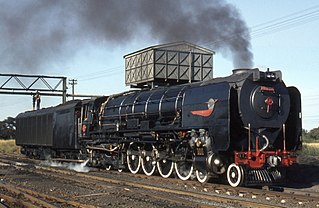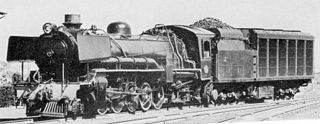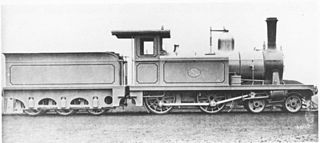
Under the Whyte notation for the classification of steam locomotives, 0-10-0 represents the wheel arrangement of no leading wheels, ten powered and coupled driving wheels on five axles and no trailing wheels. In the United Kingdom, this type is known as a Decapod, a name which is applied to 2-10-0 types in the United States. In the United States, the type is known as ten-coupled.
Under the Whyte notation for the classification of steam locomotives by wheel arrangement, a 4-8-2+2-8-4 is a Garratt articulated locomotive consisting of a pair of 4-8-2 engine units back to back, with the boiler and cab suspended between them. The 4-8-2 wheel arrangement has four leading wheels on two axles, usually in a leading bogie, eight powered and coupled driving wheels on four axles and two trailing wheels on one axle, usually in a trailing truck. Since the 4-8-2 type is generally known as a Mountain, the corresponding Garratt type is usually known as a Double Mountain.

The South African Railways Class 25 4-8-4 of 1953 was a condensing steam locomotive.

The South African Railways Class 21 2-10-4 of 1937 was a class of steam locomotives used in South Africa.

The South African Railways Class 20 2-10-2 of 1935 was a steam locomotive.

The South African Railways Class 12 4-8-2 of 1912 was a steam locomotive.

The South African Railways Class FC 2-6-2+2-6-2 of 1925 was an articulated steam locomotive.

The South African Railways Class GM 4-8-2+2-8-4 of 1938 was an articulated steam locomotive.

The South African Railways Class GO 4-8-2+2-8-4 of 1954 was an articulated steam locomotive.

The Central South African Railways Class E 4-10-2T of 1901 was a South African steam locomotive from the pre-Union era in Transvaal.

The South West African 2-8-0T of 1907 was a steam locomotive from the German South West Africa era.

The Cape Government Railways 1st Class 4-4-0TT of 1881 was a South African steam locomotive from the pre-Union era in the Cape of Good Hope.

The Cape Government Railways 1st Class 4-4-0 of 1879 was a South African steam locomotive from the pre-Union era in the Cape of Good Hope.

The South West African Class Ha 0-6-2T of 1904 was a steam locomotive from the German South West Africa era.

The South West African Jung 0-6-2T of 1904 was a narrow gauge steam locomotive from the German South West Africa era.

The South African type FT tender was a steam locomotive tender.

The South African type JV tender was a steam locomotive tender.
The South West African 0-6-0T of 1911 was a steam locomotive from the German South West Africa era.

The South West African 0-10-0 of 1911 was a steam locomotive from the German South West Africa era.

The South African type EW1 tender was a steam locomotive tender.





















